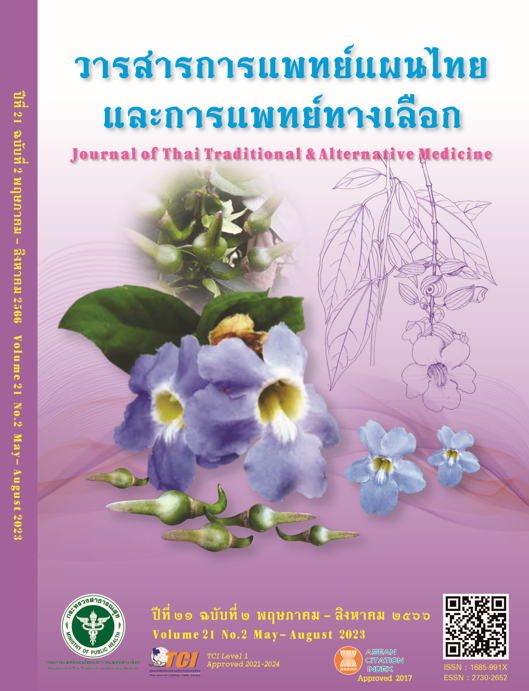Macroscopic and Microscopic Characteristics of Eupatorium fortunei Turcz.
Main Article Content
Abstract
Introduction and objective: San Phra Hom (SPH), or Eupatorium fortunei Turcz. in the family Compositae, has properties according to ancient medicinal texts using leaves. It is an antipyretic, a cold remedy, a detoxifier, and a tonic; and it is an ingredient of Ya Khiao Hom, which is included in the National List of Essential Medicines’ antipyretic group. The objective of this study was to establish the macroscopic and microscopic characteristics of SPH leaves and stems.
Methods: The macroscopic and microscopic characteristics were evaluated, including shape, color, smell, and taste. The tissue structure was investigated under a microscope.
Results: The macroscopic characteristics of dry SPH leaves and stems were greenish-brown, thin and fragile with a light smell and slightly bitter taste, while the microscopic characteristics observed included the upper and lower epidermis in surface view, lamina, midrib and petiole in cross-sectional view, and powder drugs made from leaves/petioles and stems, which are presented as color photographs and drawings under a microscope using a photography set and a drawing tube attached to the microscope.
Discussion: As SPH leaves are used as a medicinal ingredient, the collected herbal material may contain other parts of the plant such as petioles and stems. So such parts need to be studied also in order to obtain more microscopic information. The results have been recorded by drawing and photographing under more modern microscope, under which the tissues can be more realistically drawn and photographed.
Conclusion and recommendation: The macroscopic and microscopic characteristics of San Phra Hom leaves and stems have been collected. The information can be used for pharmacognostic specifications preparation, identity proofing, herb quality control, the preparation of Thai Herbal Pharmacopoeia, and analytical service provision.
Article Details

This work is licensed under a Creative Commons Attribution-NonCommercial-NoDerivatives 4.0 International License.
References
Office of Forest Herbarium, Forest and Plant Conservation Research Office, Department of National Parks, Wildlife and Plant Conservation. Tem Smitinand’s Thai plant names. 2001 revised edition. Bangkok: National Office of Buddhism Printing House; 2001. p. 229-230. (in Thai)
Flora of China. Eupatorium fortunei Turcz. Bull Soc. Imp. Naturalistes Moscou. [Internet]. 1851 [cited 2020 Apr 3]; 24(1): [1 screen]. Available from: http://www.efloras.org/florataxon.aspx?flora_id=2&taxon_id=200023934
Pongboonrod S. Mai thed Mueang Thai, folkloric uses of Thai and foreign medicinal plants. Bangkok: Krungthon printing house; 1979. 538 p. (in Thai)
Wutthithamwet W. Herbal encyclopedia: Including principles of Thai pharmaceuticals. Bangkok: O.S. Printing House; 1997. 436 p. (in Thai)
Sapcharoen P, Puripattanawong J. Pharmacy and traditional medicine. 1st ed. Nonthaburi: Bureau of Works of the War Veterans Organization under the Royal Patronage of His Majesty the King printing; 1996. p. 389. (in Thai)
The School of Traditional Medicine. Thai medicinal properties compilation of Thai medicinal properties (Part Three) relating to flora, trace elements, and various animal objects. Phra Nakhon: Office of Phra Chetuphon Temple (Wat Pho) Tha Tian; 1969. p.229-30. (in Thai)
Food and Drug Administration. Manual for the use of Thailand National List of Essential Medicines, 2021. Ayutthaya: Greatest Company Limited; 2022. 86 p. (in Thai)
Khamman S, Rolando C, Chairote G. Volatile constituents of Thai culinary herbs “San Pra Hom” (Eupatorium stoechadosmum Hance.). Chiang Mai J. Sci. 2001;28(1):17-29.
Pham TN, Pham HD, Dang DK, Duong TT, Quynh Le TP, Nguyen QD, Tien DN. Anticyanobacterial phenolic constituents from the aerial parts of Eupatorium fortunei Turcz. [Internet]. 2019 [cited 2020 Apr 3]; Available from: https://pubmed.ncbi.nlm.nih.gov/29781299.
Chavalittumrong P, Chivapat S, Attawish A. Process research on toxicology of the Herbal Research Institute Vol. I (toxicology studies of Thai herbs). Bangkok: Religious Printing House; 2003. p.17-41. (in Thai)
Ngearndee P, Jirasathaporn S. The pharmacognostical studies on Eupatorium Stoechadosmum Hance. Journal of the Department of Medical Sciences. 1979;21(1):27-39


